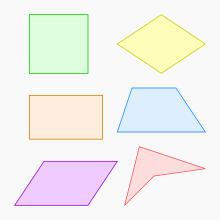Quadrilateral
| Quadrilateral | |
|---|---|

Some types of quadrilaterals
|
|
| Edges and vertices | 4 |
| Schläfli symbol | {4} (for square) |
| Area | various methods; see below |
| Internal angle (degrees) | 90° (for square and rectangle) |
In Euclidean plane geometry, a quadrilateral is a polygon with four edges (or sides) and four vertices or corners. Sometimes, the term quadrangle is used, by analogy with triangle, and sometimes tetragon for consistency with pentagon (5-sided), hexagon (6-sided) and so on.
The origin of the word "quadrilateral" is the two Latin words quadri, a variant of four, and latus, meaning "side".
Quadrilaterals are simple (not self-intersecting) or complex (self-intersecting), also called crossed. Simple quadrilaterals are either convex or concave.
The interior angles of a simple (and planar) quadrilateral ABCD add up to 360 degrees of arc, that is
This is a special case of the n-gon interior angle sum formula (n − 2) × 180°.
All non-self-crossing quadrilaterals tile the plane by repeated rotation around the midpoints of their edges.
Any quadrilateral that is not self-intersecting is a simple quadrilateral.
In a convex quadrilateral, all interior angles are less than 180° and the two diagonals both lie inside the quadrilateral.
In a concave quadrilateral, one interior angle is bigger than 180° and one of the two diagonals lies outside the quadrilateral.
A self-intersecting quadrilateral is called variously a cross-quadrilateral, crossed quadrilateral, butterfly quadrilateral or bow-tie quadrilateral. In a crossed quadrilateral, the four "interior" angles on either side of the crossing (two acute and two reflex, all on the left or all on the right as the figure is traced out) add up to 720°.
...
Wikipedia

